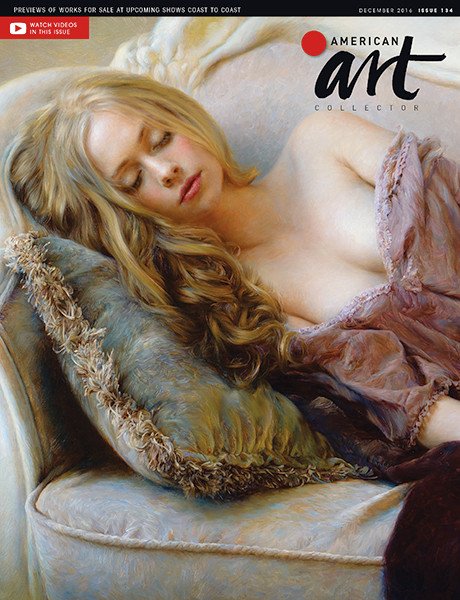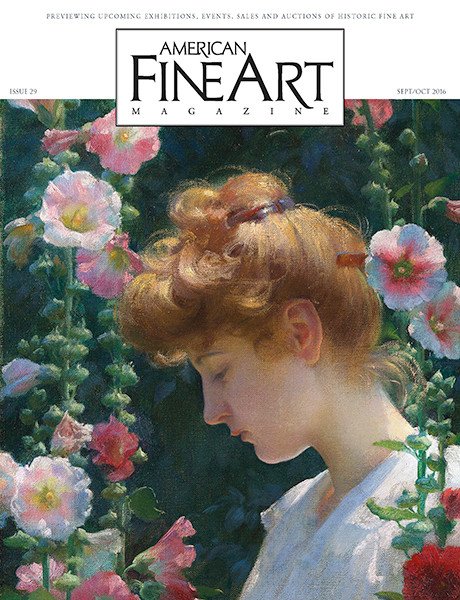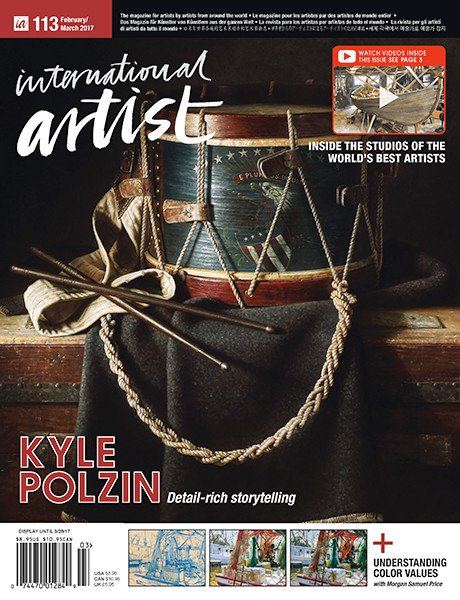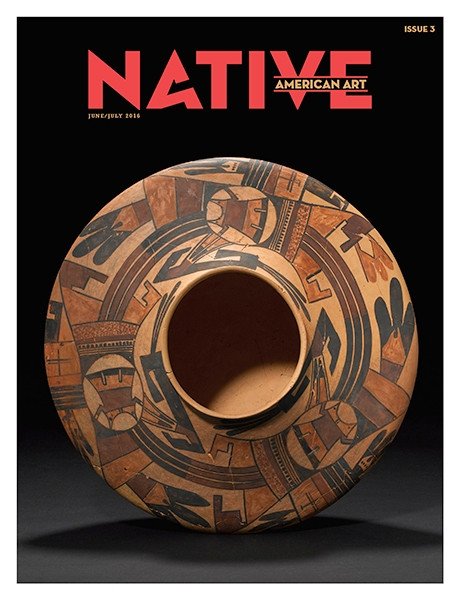Not to denigrate the recent phenomenon of “glamping”—glamours camping, a perfectly reasonable activity for those who want to experience nature—but being outdoors used to come in only one variety. The rugged, do-it-yourself, you-may-not-survive-if-you’re-not-careful variety.
This is how artists from the 19th century experienced much of the North American wilderness. They trekked to untouched lands using horses, wagons and even boats on the rivers that stretched into the frontier. There were no stores, no park rangers, no GPS and the trails were still unmarked and rocky. Even artists in the 20th century, who had more access to cars and trains, were roughing it once they hit the edge of civilization.
 Asher B. Durand (1796-1886), In the Woods, 1885, oil on canvas, 60¾ x 48 in. Gift in memory of Jonathan Sturges by his children, 1895. Metropolitan Museum of Art, 95.13.1.
Asher B. Durand (1796-1886), In the Woods, 1885, oil on canvas, 60¾ x 48 in. Gift in memory of Jonathan Sturges by his children, 1895. Metropolitan Museum of Art, 95.13.1.One work that speaks to the raw state of nature, and its danger and beauty, is Asher B. Durand’s 1885 oil painting In the Woods, now in the collection at the Metropolitan Museum of Art. Durand paints a gentle creek that snakes through a thick forest. The scene is lush with vegetation as light falls through holes in the forest canopy, and open sky at the center of the painting pulls the viewer safely toward it. And yet, there is an ominous feeling of dread that permeates within the painting. The dead and broken trunks, twisted limbs, mossy banks of the creek and gnarled roots all contribute to a sense of foreboding in a haunted, cursed place.

It’s hard to know if Carl Rungius had seen the Durand painting when he first started visiting the United States, but one could imagine that he put eyes upon In the Woodsand didn’t see danger or death, but adventure and opportunity. After a moose trip to Maine in 1894, Rungius was hooked on the vast open spaces and wildlife in North America. Today, his life and career exemplify that “roughin’ it” spirit.

Top: Carl Rungius (1869-1959), Grizzly Bear, oil on canvas, 30 x 40 in.; Legacy Gallery, Western Lilies, oil, 24 x 20 in., by Robert Peters. Bottom: Medicine Man Gallery, Myriad Manifestations, II, oil on linen, 40 x 30 in., by Bill Gallen; Carl Rungius sketching within the wilderness.
“The benefits of a life in the out-of-doors are nowhere more apparent than in the person of this painter-sportsman,” wrote William J. Schaldach in Carl Rungius: Big Game Painter. “Big game hunting in mountainous areas calls for unusual stamina, vigor and moral fiber. It takes patience and courage; it requires nerve and endurance. The man who takes an occasional, or even an annual hunt for a couple of weeks knows these things. It is a game only for the rugged and strong. Rungius has been at it for half a century; he has stalked the moose and the caribou, the grizzly, sheep, goat and antelope for more actual hunting hours than most men. For with him following big game has been more than a sport; it has been a compelling life work, with the accent placed on study. Early army training undoubtedly contributed to his ruggedness and self-reliance. These years on the trail and in remote camps have placed their stamp on the character of the man. He has had time to live, to think and to form a philosophy of life. That he has found it exceedingly good is reflected in his attitude, his spirit, and most of all, his enthusiasm.”

Left: Legacy Gallery, Moose Falls, oil, 20 x 24 in., by Matt Smith; Gallery Wild, Mornin’ Hoback, oil on linen, 72 x 48 in., by Patricia A. Griffin. Bottom: Gallery Wild, Royal Alpenglow, oil on canvas, 48 x 48 in., by Silas Thompson; Gallery Wild, It’s a Beautiful Day in the Neighborhood, oil on linen, 20 x 24 in., by Amber Blazina.
Today, as modern-day artists continue to explore the wilderness of North America, there are still unique artworks originating from these nature destinations. The lands and the animals that live within them will remain powerful forces in the world of Western art.
Stemming from the prominent collection at Legacy Gallery in Scottsdale, Arizona, are significant wilderness works from the likes of artists like Robert Peters. Born in upstate New York and raised in Phoenix, Peters credits his early memories of the Southwestern deserts with sparking a passion for the outdoors, and finding its way into pieces like Western Lilies.Enthusiasm and respect for the natural world continue to be the driving force behind his landscape paintings.

Legacy Gallery, Signs of Time, oil, 20 x 30 in., by Josh Elliott.
Artist Matt Smith contributes beauties like Moose Falls. He can often be found painting en plein air in Southern Arizona, the California coast and the Rocky Mountains. “I appreciate traditional landscape painting and I am inspired by the pristine landscapes of the American West,” the artist says. “I enjoy working in areas where one can travel for miles without seeing the influence of man. When I paint, I feel I’ve hit the mark when I’ve captured a balance between mood, look and feel.”
Another important Legacy Gallery artist, Josh Elliott, paints a variety of subjects within the landscape genre, as seen in his oil, Signs of Time.He is motivated more by ideas than a particular location. “I look for artistic elements like shapes and patterns, value relationships or color combinations,” he says. “I want there to be reason to start a painting; do I want to make it epic or poetic or maybe iconic? My hope is that it is always artistic.”

Brett Heidi, Rocky Mountain Harvest, acrylic on canvas, 20 x 20 in.
The wildlife art of Ezra Tucker, the mountainous and winter landscapes of Bill Gallen and again, Josh Elliott, as well as the etchings of Nelson Tucker, all capture the essence of the natural world in distinct and powerful ways—and are all available at Medicine Man Gallery in Tucson, Arizona.
Father and son, Ezra and Nelson Tucker, independently capture wildlife which evokes connections with nature, Their their subjects are rendered with remarkable attention to detail and vitality. Gallen’s mountain landscapes speak to the grandeur and timelessness of the outdoors, where towering peaks and sweeping vistas invite viewers to lose themselves, caught in the artist’s world. Elliott’s snowy scenes are so adroitly rendered that the viewer feels the quiet and pristine qualities of nature in a faraway, unknown, mountainous land where we are blessed with Elliott’s intimate interaction with Mother Earth.

Gary Johnson, Paddling on Glass, oil, 8 x 10 in.
When purchasing any artwork, Medicine Man Gallery owner, Mark Sublette shares, “I encourage collectors to seek pieces that resonate personally and draw out an emotion that binds you to that work. Art that speaks to the soul not only elevates the space it will live in, but continues to do so long after the credit card payment is a distant memory.”
The wilderness of the greater Yellowstone ecosystem serves as an endless source of inspiration for the artists of Gallery Wild. Many, like Amber Blazina and Silas Thompson, embrace plein air painting, immersing themselves in nature as they brave the elements to capture the region’s breathtaking beauty. Patricia A. Griffin, another artist who appreciates the meditative process of outdoor painting, finds constant inspiration in her studio, situated on the edge of Grand Teton National Park. Her striking portrait Mornin’ Hoback honors a frequent visitor to her neighborhood—a majestic bull moose. While her encounters with the animal are too brief to paint on sight, Griffin draws on her extensive photographic studies to convey his powerful presence on canvas.
For artist Joyce Cleveland,growing up in the country offered endless opportunities to observe animals. “Pheasants were in the fields and deer in the woods. The red fox patrolled the rows of grapes in search of rabbits and mice,” she describes. “Our little creek attracted them all—a perfect place to sketch.”

Top: Joyce Cleveland, Headwaters of the Snake River, oil on canvas, 24 x 18 in.; Gary Johnson, Lewis and the Bear, oil on linen, 36 x 48 in. Bottom: Dan Knepper, The Forest King, oil on canvas, 30 x 45 in.; Joyce Cleveland, A Storm is Coming, oil, 18 x 24 in.
For paintings like Headwaters of the Snake Rivers, Cleveland explains that the inspiration came from a fishing trip in Yellowstone. “I wanted to capture the feeling of a cool misty day with the Tetons in the background and the excitement of a beautiful, colorful, shiny cutthroat trout jumping out of the river with a splash,” she says.
In another engaging piece, A Storm is Coming, Cleveland captures a moment involving the pheasants she remembers from growing up in the country. “The birds, although finding a delicious meal, were always on the alert and ready to take shelter from the storm,” says the artist.

Dan Knepper, Montana, Heart and Soul, oil on canvas, 30 x 40 in
Emerging artist Joe Pinson grew up surrounded by the art and culture of Santa Fe, New Mexico, where he was drawn to the bronze sculptures on display in the city’s numerous galleries. This kindled a desire to create his own sculptures that finally came to fruition in 2024 with the casting of Bull Creek Canyon.
Pinson also finds inspiration in the untouched places found in the wilderness of the West and his passion for wildlife. “Bull Creek Canyonwas inspired by an encounter I had with an elk herd in the mountains of New Mexico,” explains Pinson of his bronze beauty. “Art that depicts wildlife and wilderness should create a desire to experience the scene for yourself. Maybe it evokes a memory or maybe it is something you have never seen, but either way you want to be there.”

Joe Pinson, Bull Creek Canyon, bronze, limited ed. of 15, 28 x 28 x 22 in.
Dan Knepper loves the mountains. “I’m happiest with a palette of a sky so blue viewers wouldn’t believe it to be true; of the greens of sage, and pine and cedar; the teal and aquamarine of crystal-clear lakes and streams,” he so poetically details. “And I love the giants—the bison, elk, bear and the mountains themselves. There’s a breathtaking composition everywhere you look. I never tire of exploring and hope the viewer shares in my adventures.”
As for collecting within the genre, Knepper says, “Forget about style and technique. Buy a destination and adventure. Buy a painting you’ll want to stand in front of and step into again and again.”
For his piece Lewis and The Bear, painted for The Russell auction, artist Gary Johnson shares that he’s in awe of the Lewis and Clarke expedition. “This painting is of a singular event that happened to Meriwether Lewis on June 14, 1805, while scouting ahead of the group along the Missouri River, in what is now Great Falls, Montana,” says Johnson. “Intending to camp by himself overnight, he shot a bison for food. A grizzly bear snuck up on him before he reloaded his rifle. He outran the bear 80 yards to the river, jumped in the water and confronted the bear with his espontoon. The bear then ran off. I worked closely with the Lewis & Clarke Center in Great Falls to make this depiction as accurate as possible. A full-size reproduction of this painting hangs on display there.
In the more tranquil scene, Paddling on Glass,we find a small painting embodying Johnson’s love of canoeing. “I live on a lake,” he says, “and canoe as often as possible.”

Medicine Man Gallery, In Between Winter and Spring, oil on board, 35 x 32 in
Artist Brett Heidi grew up in a special place, “where the prairies meet the majestic Rockies,” she says. “Life here is filled with views of farm fields, backdropped by rolling foothills that lead to pristine mountains. These scenes are not static but ever-changing with the weather and the passing of seasons.”
When painting this contrast, Heidi tries to convey the excitement that she feels every time she steps outside and look to the west. “I feel energized by a passing thunderstorm in the summer, uplifted when the fields turn vibrant yellow with canola blooms, and enriched by the golden wheat fields during the fall harvest,” she describes. “The palette created by light sets the perfect tone for every scene. For example, as nearby fields are kissed with the power of the sun, their mountainous backdrop becomes an even richer blue. Every moment spent outdoors is an opportunity to experience a unique masterpiece of the natural world.”

Medicine Man Gallery, Bull Moose Portrait Drawing, drawing pencil on stretched canvas, 30 x 40 in., by Ezra Tucker.
Find Heidi’s work at Best of the West in Great Falls, Montana from March 20 to 23; Calgary Stampede Western Art Show from July 4 to 13; and Pure West Art & Artifact Auction on June 22. —
Featured Artists & Galleries
Joyce Cleveland
www.joyceclevelandfineart.com
Gallery Wild
info@gallerywild.com
www.gallerywild.com
Jackson Hole, WY — (307) 203-2322
Santa Fe, NM — (505) 467-8297
Brett Heidi
Alberta, Canada, (403) 415-5179
www.brettheidi.com
Gary Johnson
(760) 402-9986, www.garyjohnson.com
Dan Knepper
(937) 489-1078
danknepperart@yahoo.com
www.danknepperart.com
Legacy Gallery
7178 Main Street, Scottsdale, AZ 85251
(480) 945-1113
www.legacygallery.com
Medicine Man Gallery
6872 E. Sunrise Drive, #130 Tucson, AZ 85750,
(520) 722-7798 www.medicinemangallery.com
Metropolitan Museum of Art
1000 Fifth Avenue, New York, NY 10028
(212) 535-7710, www.metmuseum.org
Joe Pinson
www.joepinsonart.com
Instagram: joepinsonart
Powered by Froala Editor







































